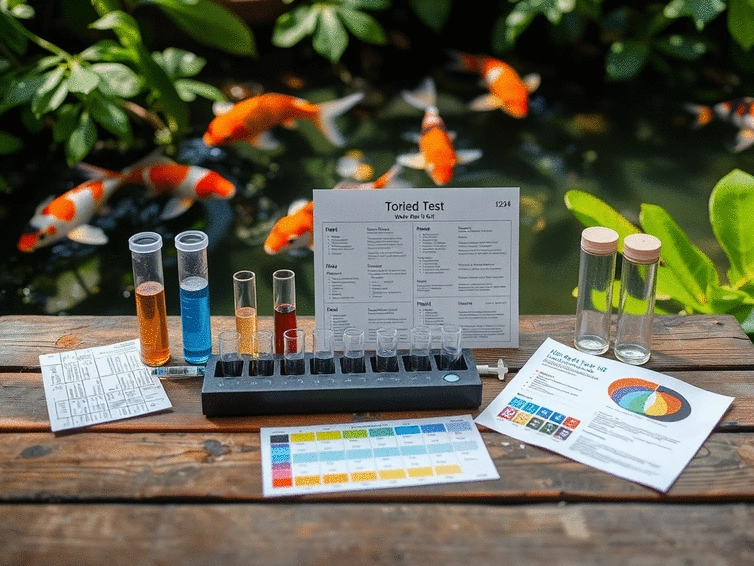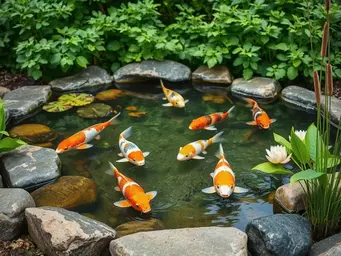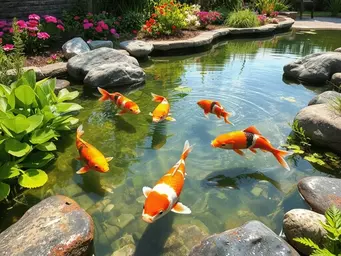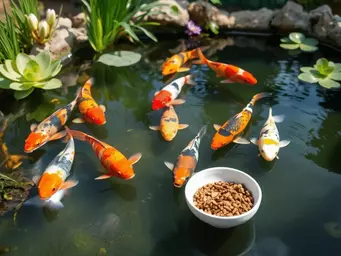Critical Water Parameters
Overview
7.0 - 8.6
(Stable Environment)
Undetectable
(< 0.02 mg/L)
0 mg/L
(Avoid Stress)
< 40 mg/L
(Limit Algae Growth)
100-300 ppm
(Mineral Balance)

Water quality can make or break your koi pond experience. Understanding how to maintain optimal conditions not only enhances the health of your koi but also ensures a vibrant and serene aquatic environment. Ready to dive into the essentials of koi pond care?
Maintaining optimal water quality is paramount for the health and vibrancy of your koi. The visual below details the critical parameters to monitor and their ideal ranges.
7.0 - 8.6
(Stable Environment)
Undetectable
(< 0.02 mg/L)
0 mg/L
(Avoid Stress)
< 40 mg/L
(Limit Algae Growth)
100-300 ppm
(Mineral Balance)
API Pond Master Test Kit
Aqua Care Pro
Lifegard Aquatics
Tetra & Seachem
Test water regularly (at least weekly in warmer months).
Keep a log of results to spot trends and issues.
Invest in quality filtration systems for clean water.
Your koi pond is not just a beautiful addition to your backyard; it's a living ecosystem that needs attention and care. Understanding the importance of water quality is essential for maintaining a healthy environment for your koi. Regular monitoring helps in keeping the water conditions just right, ensuring your fish thrive and your pond looks stunning!
At Best Koi Ponds, I’ve seen firsthand how even minor fluctuations in water quality can lead to significant health issues for koi. By prioritizing water quality, you can prevent problems before they arise, making your koi-keeping experience much more enjoyable and rewarding.
Water testing is crucial for maintaining the health of your koi. The majority of fish diseases are linked to poor water quality, which can stem from unmonitored parameters. Regular testing allows us to identify issues early and take necessary action before it’s too late. For a deeper understanding of water quality monitoring, you might find research on the topic useful, such as articles available on PMC (NCBI).
By making regular water testing a part of your routine, you create a stable and healthy environment for your koi to flourish. Trust me; your koi will thank you for it!
When it comes to water quality, there are a few key parameters you absolutely should monitor: pH, ammonia, and nitrites. These factors play a pivotal role in the health of your fish and the overall balance of your pond. General information on water quality can also be found on resources like Wikipedia.
Keeping these parameters in check will contribute significantly to the well-being of your koi. Regular testing provides peace of mind and helps you address any issues that may arise promptly.
While pH, ammonia, and nitrites are crucial, we must also consider nitrate and hardness in our water quality assessments. Understanding these elements ensures a well-rounded approach to koi pond care. For more general advice on koi fish care, including water testing, you can refer to resources like PetMD.
By being vigilant about these parameters alongside pH, ammonia, and nitrites, you’ll create a balanced and healthy aquatic environment. It's all about synergy; each factor plays a role in the thriving ecosystem of your koi pond!
To ensure the best water quality for your koi pond, consider investing in an automated water monitoring system. These devices can continuously track pH, ammonia, and nitrite levels, sending alerts directly to your smartphone. This proactive approach allows you to maintain optimal conditions for your koi without the hassle of manual testing.
As we delve into the world of koi pond water testing, it's crucial to highlight the best options available to ensure the health and vibrancy of our aquatic friends. After reviewing various kits, we can pinpoint some key features that stand out across the board. Whether you’re a novice or an experienced koi keeper, understanding these options can help you maintain a thriving ecosystem.
Here’s a recap of the key features and benefits of the kits we've explored:
By comparing these features, you can select the kit that aligns best with your koi pond care routine. Remember, investing in a quality test kit is investing in your koi's health!
Choosing the right water testing kit can feel overwhelming, but it doesn’t have to be! As someone who has spent years designing and maintaining koi ponds, I recommend considering a few factors before making a decision:
Taking these aspects into account will not only streamline your decision-making process but also help you maintain optimal water quality for your koi.
At Best Koi Ponds, we emphasize the importance of maintaining water quality for the health of your koi. Here are some expert recommendations I’ve gathered over the years:
With these tips in mind, you’re well on your way to creating a vibrant and healthy koi pond environment. Remember, the joy of koi keeping is not just about the fish but also about the beauty and serenity of the pond itself!
I’d love to hear how your water testing journey has been! Have you found specific kits that work better for you? Let’s share our experiences and tips to help our community grow stronger!
Don’t forget to check back regularly for new guides and reviews at Best Koi Ponds. We’re dedicated to helping you create and maintain the koi pond of your dreams!
Here is a quick recap of the important points discussed in the article:
Koi Pond Budgeting Made Simple

Building a koi pond is not just about creating a beautiful water feature; it’s an investment that
Building a Self-Sustaining Koi Pond

Creating a self-sustaining koi pond is not just about aesthetics; it's about building a harmonious e
Koi Care Tips for Every Season

Did you know that the health of your koi is intricately linked to the seasons? Understanding how to
Koi Pond Budgeting Made Simple
Building a Self-Sustaining Koi Pond
Koi Care Tips for Every Season
Managing Koi Pond Chemical Levels
Koi Pond Building Mistakes to Avoid